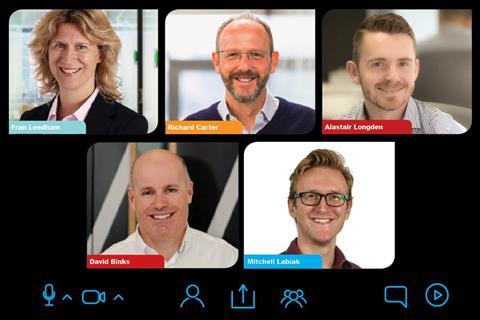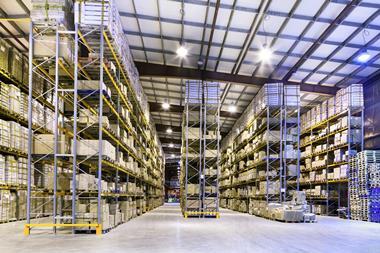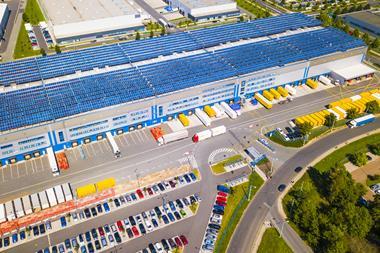Following a year in which the industrial and logistics market broke almost every record going, it has never been more important for the sector to consider the needs of occupiers.

Panel of experts
Fran Leedham, head of responsible business, St. Modwen
Richard Carter, senior director – construction, St. Modwen
Alastair Longden, director, UMC Architects
David Binks, senior director – leasing, St. Modwen Logistics
Mitchell Labiak, chief investigative reporter/moderator, Property Week
That was the focus of Property Week and St. Modwen’s webinar last month. The hot topics of discussion were sustainability, wellbeing and design, along with the burning question of how developers can improve all these things for the sake of their occupiers while still making a scheme viable.
The one-hour online event kicked off with a presentation from Richard Carter, senior director of construction at St. Modwen, and Fran Leedham, head of responsible business at St. Modwen.
Watch a teaser trailer for the webinar on the player below:
Alternatively, click here to watch the webinar in FULL on demand here.
Leedham began by stressing that her background in working at consumer-facing organisations such as JLL and Jaguar Land Rover means she prefers to use the term ‘customer’ rather than ‘occupier’.
“We’re focused on delivering exceptional experiences through the buildings and the services we provide, and our responsible business ambitions are an integral part of our foundations in delivering this,” she said.
Leedham explained how St. Modwen regenerated the ex-British Leyland Longbridge plant into a “sustainable community creating around 10,000 new jobs, 4,000 new homes and 2m sq ft of commercial development with a new college and a green park in the centre of it”.
She added: “It is this heritage of regeneration that has enabled us to understand what really matters and define our purpose: changing places and creating better futures. This flows through everything we do. It guides the way we conduct ourselves; how we deliver for our customers and understand their needs; how we protect our environment; and how we enhance the wellbeing of our communities.”
Carter explained how St. Modwen’s Swan Standard helps to reduce net carbon; improve biodiversity and environmental conditions; improve health and wellbeing; and ensure responsible operating practices and partnerships. This can mean creating green spaces in between buildings, developing ‘blue infrastructure’ such as ponds or improving the energy efficiency of buildings. He stressed how all St. Modwen logistics projects are BREEAM ‘Excellent’-certified as part of its Swan Standard.
He added: “We at St. Modwen are really proud to have developed what I believe are a set of guiding principles that will enable us to consistently deliver high-quality modern industrial and logistics parks to meet the demand of our customers today and tomorrow.”
The presentation was followed by a conversation with Alastair Longden, director at UMC Architects, who explained how architects are adapting to the changing needs of occupiers.
“Gone are the days when we as architects are merely tasked with maximising density,” he said. “Historically, we would look at a scheme and really try to get every last sq ft of yield out of the site. But, nowadays, we’re challenged more from a sustainability and wellness point of view. We’re creating parks here, not just high-density industrial estates.”
Nowadays, we’re challenged more from a sustainability and wellness point of view
Alastair Longden
Longden then talked about what this approach means in practice.
“One of the key elements of the Swan Standard is to look at converting constraints into opportunities. In the past, we would look at a drain or a stream running through a site as a constraint and we would work with the other consultants to push that to the boundary and remove it from the site.
“This new mindset we’re adopting with St. Modwen means we can take that as an opportunity and weave that stream or watercourse through the site, thus introducing a running water element to the scheme and bringing wellness benefits from that particular element that would have previously been considered a constraint.”
The conversation with Longden was followed by a discussion with David Binks, senior director of leasing at St. Modwen Logistics, who spoke about what occupiers are looking for when choosing sites and what landlords can do about this.
“In a utopian world, the amount of interaction between a landlord and a customer is limited because customers are doing well in the buildings and are happy with what’s going on. But customers’ requirements of landlords are changing. They are expecting far more of an experience and a service from their landlords now and in the future. Space is becoming much more of a service rather than a commodity.”
Binks stressed that “every single customer is different”, citing by way of example two almost identical speculative buildings that St. Modwen developed; one had some doors taken out while another had more doors put in according to the different requirements of the two occupiers.
“You have to really engage with customers, understand their requirements and partner with them in a really big way to make the adjustments to the buildings that they need,” said Binks.
“Often with customers, they don’t know what they need. So, we take a gently challenging approach to customers about fit-out to really guide and explore what they actually want and need. We find that a valuable process and we know our customers find that a valuable process from the feedback we’ve had.”
We’ve set our own commitments to achieve net zero carbon and it flows directly into the Swan Standard
Fran Leedham
Binks said that this gentle challenging of customer needs tend to happen on specific elements of a scheme, such as lighting or power.
“We often get approached by customers with some pretty big day one power requirements, but when you really explore it with them and discuss it with them you very quickly realise that they don’t need all the power immediately on day one and the power can be delivered over time. This often makes the power conversation much simpler.”
The final session of the webinar featured the results of an audience poll followed by a Q&A between all four presenters. Asked what the most important thing occupiers look for in an industrial or logistics space is, more than 80% of the audience said “good location” while the remaining 20% were split between affordability, sustainability credentials, good design and employee wellbeing.
Leedham answered the first question of the Q&A, which was about how net zero targets factor into the Swan Standard.
“It’s one of the top priorities for the company and one of our six responsible business commitments. We’ve set our own commitments to achieve net zero carbon and it flows directly into the Swan Standard.”
Asked if the Swan Standard had brought any additional cost implications to the business, Carter said: “At first glance, you’d say ‘yes it has’, but we pay a lot of attention to clever design work. So, where we’ve had cost rise with the introduction of sustainable credentials, we’ve just looked at how we can offset with clever design and clever product selection.”
On the question of how developers can balance the additional costs of sustainability with viability considerations, Binks said: “There are definitely added value benefits when you think about the viability aspects of applying Swan Standard codes to a park. For us, that comes out in the speed at which we lease the accommodation. The Swan Standard is helping us lease space faster and that has benefits.”
Longden said he believed the high-end design principles the presenters had been talking about throughout the webinar would become standard practice in future.
“Without a doubt, this is going to be a step change for the industry. I think we are going to see many more developers following suit.”






























No comments yet